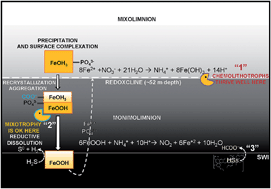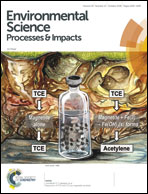Iron and nitrogen cycling, bacterioplankton community composition and mineral transformations involving phosphorus stabilisation in the ferruginous hypolimnion of a post-mining lake†
Abstract
Lake Medard is an oligotrophic post-mining lake characterised by ferruginous bottom waters, with marked redox gradients resulting from iron (Fe) and nitrogen (N) speciation and accompanying depth-dependent variations in the abundance of volatile fatty acids (VFAs), pH and alkalinity. The lacustrine system is meromictic, featuring a dysoxic hypolimnion and an anoxic monimolimnion with relatively high concentrations of sulfate (SO42−, 19 ± 2 mM) and Fe(II) (127 ± 17 μM). An increase in dissolved manganese is also observed with increasing depth, together with a general lack of sulfide, which can only be detected at the sediment–water interface at concentrations of ∼0.30 μM. In the hypolimnion, nitrate (NO3−) becomes progressively depleted and ammonium (NH4+) dominates the dissolved N inventory (up to 185 ± 13 μM). Here we describe the biogeochemical disequilibrium conditions governing critical mineralogical transformations involving Fe and phosphorus (P) co-precipitation in the dysoxic-to-anoxic bottom water column. A combination of mineral equilibrium modelling and synchrotron-based diffraction and spectroscopic techniques was applied to investigate the minerals comprising the upper anoxic sediments. The combined dataset indicates that elemental recycling on and below the hypolimnion promote the precipitation of FeOOH polymorphs that accumulate as heterogeneous mineral clusters. Changes in the relative abundance of bacterioplankton taxa with increasing water depth point to a link between the activity of certain members of Proteobacteria and the co-recycling of carbon (C), N, and Fe stocks. Such a redox recycling process seems to lead to P stabilisation into organic-rich Fe-(oxyhydr)oxides near and above the anoxic sediment–water interface (SWI).



 Please wait while we load your content...
Please wait while we load your content...